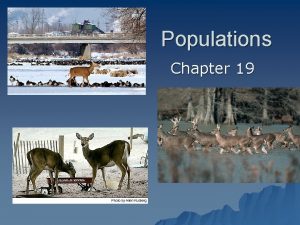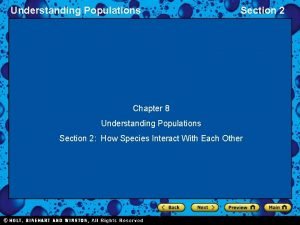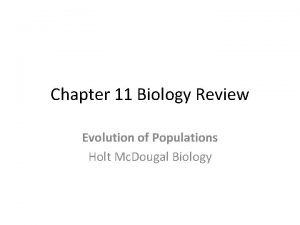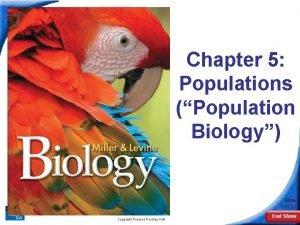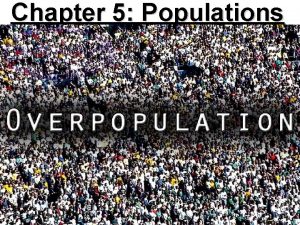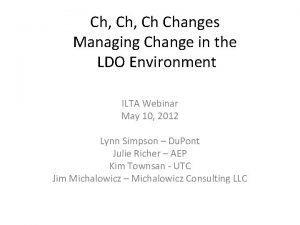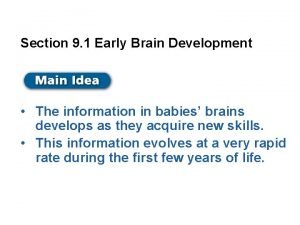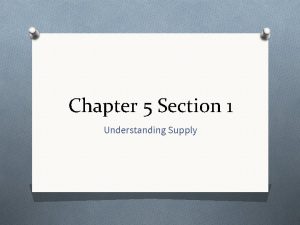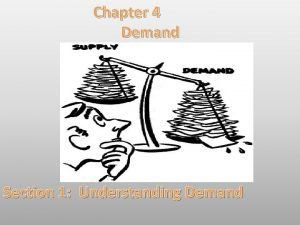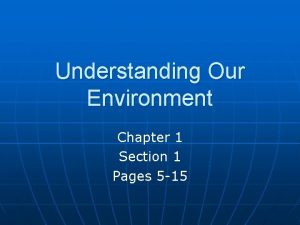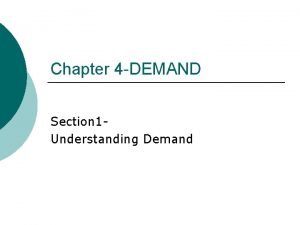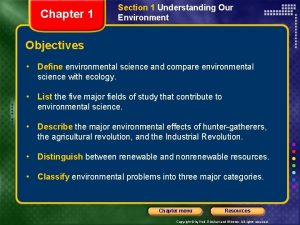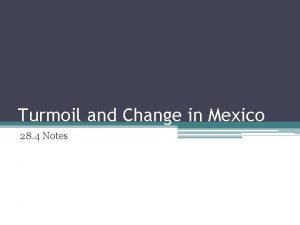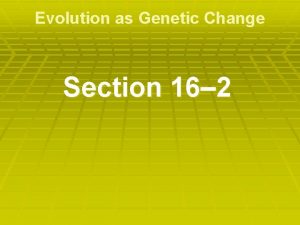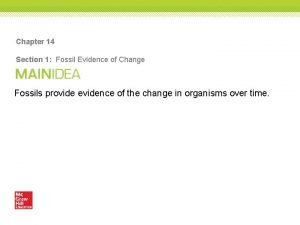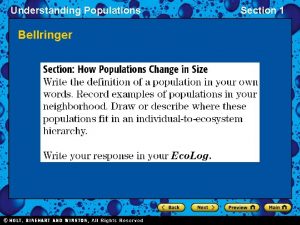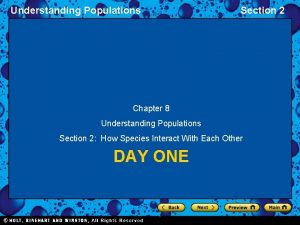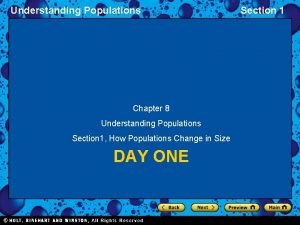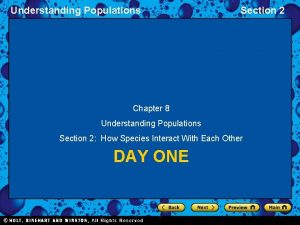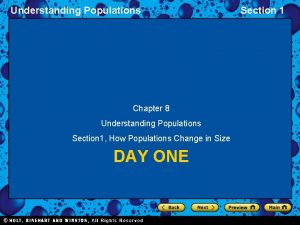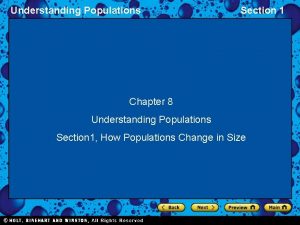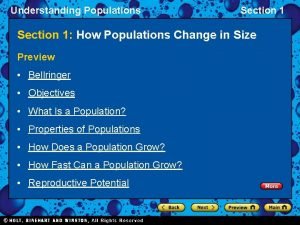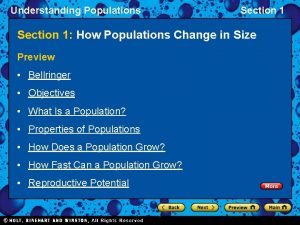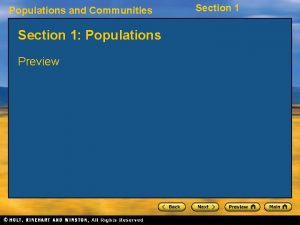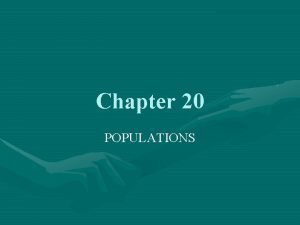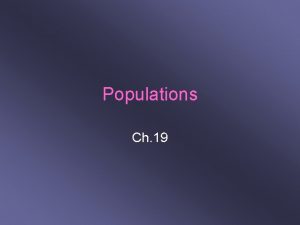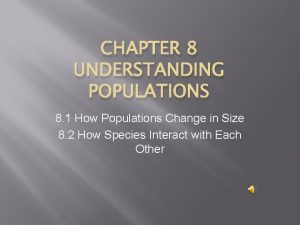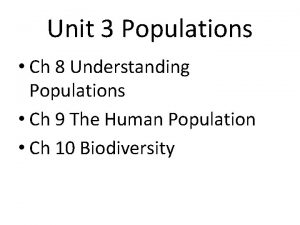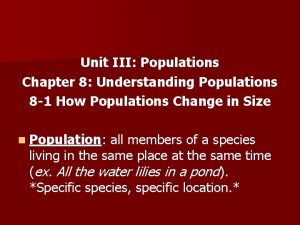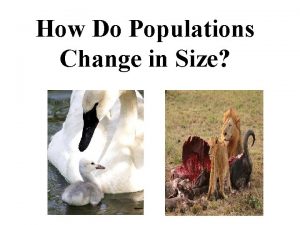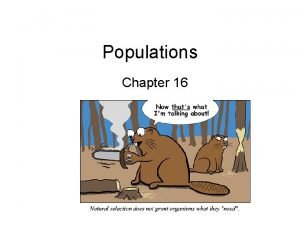Understanding Populations Section 1 How Populations Change in






































- Slides: 38

Understanding Populations Section 1: How Populations Change in Size

Understanding Populations Section 1 Objectives • Describe three main properties of a population. • Describe exponential population growth. • Describe how the reproductive behavior of individuals can affect the growth rate of their population. • Explain how population sizes in nature are regulated.

Understanding Populations Section 1

Understanding Populations Section 1 • The first options gives a total of : 10 +15+20+25 = $70 • The double option will give you:

Understanding Populations Day 1 2 3 4 5 No. of Pennies Given 1 1 x 2=2 2 x 2=4 4 x 2=8 8 x 2 = 16 Section 1 Total No. of Pennies 1 1+2 = 3 1+2+4 = 7 1+2+4+8 = 15 1+2+4+8+16 = 31 = 2^n - 1 2^30 - 1 = 1, 073, 741, 824 - 1 = 1, 073, 741, 823 pennies. That's more than a billion pennies! If we divide this number by 100 (remember, there are 100 pennies in a dollar: 1, 073, 741, 823 divided by 100 = $10, 737, 418. 23. That's almost eleven million dollars!

Understanding Populations Section 1 Populations can increase in similar ways…

Understanding Populations Section 1 What Is a Population? • A population is a group of organisms of the same species that live in a specific geographical area and interbreed.

Understanding Populations Section 1 Properties of Populations • Density is the number of individuals of the same species that live in a given unit of area. • Dispersion is the pattern of distribution of organisms in a population. A population’s dispersion may be even, clumped, or random. • Size, density, dispersion, and other properties can be used to describe populations and to predict changes within them.

Understanding Populations Section 1

Understanding Populations Section 1 How Does a Population Grow? • A population gains individuals with each new offspring or birth and loses them with each death. • The resulting population change over time can be represented by the equation below.

Understanding Populations Section 1 How Does a Population Grow? • Growth rate is an expression of the increase in the size of organisms or population over a given period of time. It is the birth rate minus the death rate. • Overtime, the growth rates of populations change because birth rates and death rates increase or decrease. • For this reason, growth rates can be positive, negative, or zero.

Understanding Populations Section 1 Population growth rate Birth rate Death rate Positive Negative Zero

Understanding Populations Section 1 How Does a Population Grow? • For the growth rate to be zero, the average number of births must equal the average number of deaths. • If the adults in a population are not replaced by new births, the growth rate will be negative and the population will shrink.

Understanding Populations Section 1 How Fast Can a Population Grow? • Populations usually stay about the same size from year to year because various factors kill many individuals before they can reproduce. • These factors control the sizes of populations. • In the long run, the factors also determine how the population evolves.

Understanding Populations Math Practice Section 1

Understanding Populations Section 1

Understanding Populations Section 1 Biotic potential Is the ability of a population of living species to increase under ideal environmental conditions – sufficient food supply, – no predators, – and a lack of disease.

Understanding Populations Section 1 Reproductive Potential • A species’ biotic potential is the fastest rate at which its populations can grow. This rate is limited by reproductive potential. • Reproductive potential is the maximum number of offspring that a given organism can produce.

Understanding Populations Section 1 Some species have much higher reproductive potentials than others. Darwin calculated that it could take 750 years for a pair of elephants to produce 19 million descendants. While bacteria could produce that in a few days or weeks

Understanding Populations Section 1 Reproductive Potential • Reproductive potential increases when individuals – produce more offsprings at a time, – reproduce more often, and – reproduce earlier in life. • Reproducing earlier in life has the greatest effect on reproductive potential.

Understanding Populations Section 1 Reproductive Potential • Small organisms, such as bacteria and insects, have short generation times and can reproduce when they are only a few hours or a few days old. • As a result, their populations can grow quickly. • In contrast, large organisms, such as elephants and humans, become sexually mature after a number of years and therefore have a much lower reproductive potential than insects.

Understanding Populations Quick LAB Section 1

Understanding Populations Section 1

Understanding Populations Section 1 Exponential Growth • Exponential growth is logarithmic growth or growth in which numbers increase by a certain factor in each successive time period. • Exponential growth occurs in nature only when populations have plenty of food and space, and have no competition or predators. • For example, population explosions occur when bacteria or molds grow on a new source of food.

Understanding Populations Exponential Growth • In exponential growth, a large number of individuals is added to the population in each succeeding time period. Section 1

Understanding Populations Section 1 After they were protected from hunting, the elephants in Kruger National Park (South Africa) experienced birth rates exceeding death rates for 60 years. This population growth is reflected in a J-SHAPED expotential growth curve.

Understanding Populations Section 1 What Limits Population Growth? • Because natural conditions are neither ideal nor constant, populations cannot grow forever. • Eventually: – resources are used up or – the environment changes, and – deaths increase or births decrease.

Understanding Populations Section 1 Under the forces of natural selection in a given environment, only some members of any population will survive and reproduce. Thus, the properties of a population may change over time.

Understanding Populations Section 1 Activity Choose your candy

Understanding Populations Section 1 Carrying Capacity • Carrying capacity is the largest population that an environment can support at any given time. • A population may increase beyond this number but it cannot stay at this increased size.

Understanding Populations Section 1 Because ecosystems change, carrying capacity is difficult to predict or calculate exactly. However, it may be estimated by looking at average population sizes or by observing a population crash after a certain size has been exceeded.

Understanding Populations Carrying Capacity Section 1

Understanding Populations Section 1 Resource Limits • A species reaches its carrying capacity when it consumes a particular natural resource at the same rate at which the ecosystem produces the resource. • That natural resource is then called a limiting resource. • The supply of the most severely limited resources determines the carrying capacity of an environment for a particular species at a particular time.

Understanding Populations Section 1 Competition Within a Population • The members of a population use the same resources in the same ways, so they will eventually compete with one another as the population approaches its carrying capacity. • Instead of competing for a limiting resource, members of a species may compete indirectly for social dominance or for a territory. • Competition within a population is part of the pressure of natural selection.

Understanding Populations Section 1 Competition Within a Population • A territory is an area defended by one or more individuals against other individuals. • The territory is of value not only for the space but for the shelter, food, or breeding sites it contains. • Many organisms expend a large amount of time and energy competing with members of the same species for mates, food, or homes for their families.

Understanding Populations Section 1 Two Types of Population Regulation • Population size can be limited in ways that may or may not depend on the density of the population. • Causes of death in a population may be – density dependent or – density independent.

Understanding Populations Section 1 • When a cause of death in a population is density dependent: – deaths occur more quickly in a crowded population than in a sparse population. • This type of regulation happens when individuals of a population are densely packed together. • Causes: – Limited resources, – predation and – disease result in higher rates of death in dense populations than in sparse populations.

Understanding Populations Section 1 • When a cause of death is density independent, – a certain proportion of a population may die regardless of the population’s density. • This type of regulation affects all populations in a general or uniform way. • Causes: – Severe weather and – natural disasters are often density independent causes of death.
 Section 19-2 review measuring populations
Section 19-2 review measuring populations Chapter 8 understanding populations
Chapter 8 understanding populations Stabilizing selection human birth weight
Stabilizing selection human birth weight Section 5-3 human population growth
Section 5-3 human population growth Evolution of populations section 16-1 genes and variation
Evolution of populations section 16-1 genes and variation Evolution of populations section 11 review
Evolution of populations section 11 review Section 5-1 how populations grow
Section 5-1 how populations grow Section 5-1 how populations grow
Section 5-1 how populations grow Change curve+awareness+understanding+acceptance+commitment
Change curve+awareness+understanding+acceptance+commitment Understanding brain structure section 9-1
Understanding brain structure section 9-1 Section 1 understanding supply
Section 1 understanding supply Lesson 1: understanding demand
Lesson 1: understanding demand Chapter 1 section 1 understanding our environment answers
Chapter 1 section 1 understanding our environment answers Economics chapter 4 section 1 understanding demand answers
Economics chapter 4 section 1 understanding demand answers Section 1 understanding our environment answer key
Section 1 understanding our environment answer key Is mashing potatoes a chemical change
Is mashing potatoes a chemical change Meaning of physical change
Meaning of physical change Absolute change and relative change formula
Absolute change and relative change formula Integer operations
Integer operations Difference in physical and chemical changes
Difference in physical and chemical changes Difference between supply and quantity supplied
Difference between supply and quantity supplied Supply and demand curve shifts
Supply and demand curve shifts Change your water change your life
Change your water change your life Reactive change is change that
Reactive change is change that Physical change and chemical change
Physical change and chemical change Spare change physical versus chemical change
Spare change physical versus chemical change Rocks change due to temperature and pressure change
Rocks change due to temperature and pressure change Whats a chemical change
Whats a chemical change How does a physical change differ from a chemical change? *
How does a physical change differ from a chemical change? * Chemical change in baking
Chemical change in baking First and second order change in education
First and second order change in education Is a magnet sticking to the refrigerator a chemical change
Is a magnet sticking to the refrigerator a chemical change Climate change 2014 mitigation of climate change
Climate change 2014 mitigation of climate change Chapter 28 section 4 turmoil and change in mexico
Chapter 28 section 4 turmoil and change in mexico Section 16–2 evolution as genetic change
Section 16–2 evolution as genetic change Chapter 3 section 3 change by other means worksheet answers
Chapter 3 section 3 change by other means worksheet answers Chapter 14 section 1 fossil evidence of change answer key
Chapter 14 section 1 fossil evidence of change answer key Chapter 13 atmosphere and climate change section 1
Chapter 13 atmosphere and climate change section 1 The history of life section 1 fossil evidence of change
The history of life section 1 fossil evidence of change
